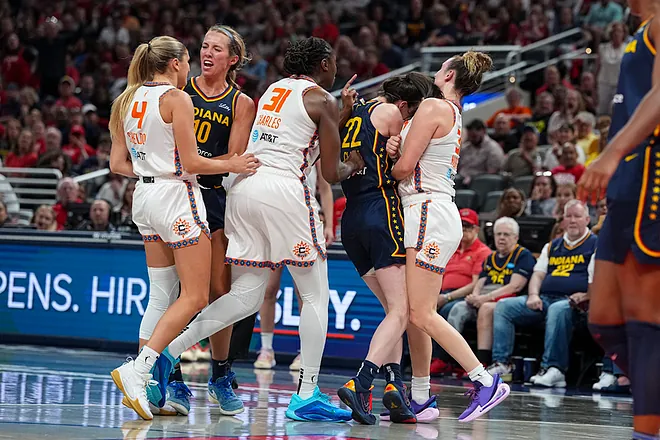Caitlin Clark has become the epicenter of attention, intensity, and aggression in the WNBA, a league where talent reigns and rivalries are born quickly. Since her electrifying transition from college stardom at Iowa to the professional stage, Clark has been under a microscope—an icon in the making, both praised for her dazzling skill set and tested by the fire of veteran competition. In recent games, it’s been impossible to ignore what appears to be a coordinated effort to rattle the Indiana Fever rookie. From hard fouls to constant double teams, from physicality that borders on excessive to mental mind games, Caitlin Clark is being hunted on the hardwood. But instead of backing down, she’s absorbing it all—and still rewriting records as the spotlight only grows brighter.
Each time Clark steps onto the court, it feels like a battle beyond basketball. She’s not just facing a team; she’s facing a league intent on testing her toughness. Opponents come out with a chip on their shoulder, determined to prove that the rookie sensation won’t get any easy passes at this level. It’s a dynamic rarely seen with such consistency, especially this early in a career. But Clark is no ordinary rookie. Her college tenure was one for the ages, filled with logo threes, highlight-reel passes, and a scoring flair that elevated women’s basketball to a new level of cultural relevance. That prominence, however, has also made her a target.
In game after game, Clark has been swarmed by defenders, bumped, bodied, and knocked to the floor. The double teams start the moment she crosses half court, a tactic that seems less about strategy and more about statement. “Welcome to the league” has taken on a different meaning for Clark—it’s not a handshake or a nod of respect. It’s two defenders in her face, a third waiting in the paint, and an extra shove thrown in after the whistle. Some call it gritty defense. Others see it as a systematic campaign to knock her off her game. Whatever the interpretation, the fact remains: no other player is being guarded like this on a nightly basis.
The treatment isn’t limited to physical contact. There’s the verbal taunting, the side-eye glares, and the cold shoulders during warmups and postgame moments. It’s as if some players have made it their personal mission to humble her, perhaps bristling at the media attention she’s garnered before proving herself in the WNBA. Yet despite the noise and the bumps and bruises, Clark keeps showing up. She continues to produce—hitting deep threes, dishing out assists, and maintaining composure that belies her age. Her stat lines are often impressive, but it’s her resilience that’s becoming her defining trait.
What makes this all the more jarring is the contrast between Clark’s on-court demeanor and the aggression she faces. She doesn’t retaliate. She rarely complains. She gets up, fixes her ponytail, and locks back in. That poise has won her admiration from fans and analysts alike, many of whom believe she’s being unfairly targeted. Social media erupts after every hard foul or questionable non-call, with fans voicing concern that the league is allowing too much leeway in how she’s being defended. The criticism has grown so loud that even former players and media personalities have weighed in, calling for more consistent officiating and protection for all players, regardless of status.
The Fever, meanwhile, have remained supportive but cautious. They understand Clark’s value not just to their franchise but to the league as a whole. She’s a ticket-seller, a viewership booster, and a generational talent. But they also recognize that the WNBA has never been a league to coddle newcomers. Earning respect here means enduring the fire, and Clark is clearly going through it. Still, questions are beginning to emerge about how much of this is normal “rookie hazing” and how much is veering into territory that could affect her health and longevity.
The most recent examples of this double aggression were particularly jarring. In one contest, Clark was shoved to the ground with no whistle, then poked in the eye during a scramble for the ball. As she clutched her face and stayed down, the crowd gasped, and the replay only intensified the outrage. Commentators questioned the absence of a foul call, while fans demanded accountability. These moments are piling up, and with each one, the narrative grows: Caitlin Clark is being hunted—and the league needs to respond.
To Clark’s credit, she hasn’t allowed the chaos to consume her. Her postgame interviews remain thoughtful and mature. She speaks about team progress, about learning and adjusting, about taking ownership even when it’s not her fault. It’s a leadership style forged in the high-stakes pressure cooker of her college career and now being hardened in the professional crucible. She doesn’t seek pity. She wants to earn her place. But that doesn’t mean the treatment she’s receiving should go unchallenged.
There’s a deeper conversation happening here—one about how the WNBA balances competition with protection. Yes, the league is physical. Yes, veterans want to make rookies earn their stripes. But when physicality turns into targeting, when intensity crosses into intent to harm, there must be boundaries. The product suffers when stars are injured or intimidated into playing timidly. And whether fans love or loathe Clark, no one can deny she brings energy and excitement that benefits everyone. When she’s allowed to play her game, the whole league shines.
Clark’s teammates have also started to rally around her more vocally. The Fever have responded to the elevated physicality with increased toughness of their own. While they’re a young squad still finding their identity, there’s a noticeable shift in their body language. They’re standing taller, setting harder screens, and chirping back when needed. Clark’s grit appears contagious. Even in games where the team struggles, her presence forces opponents to overcommit, opening opportunities for others. That’s impact. That’s leadership. That’s what great players do.
Still, this baptism by fire is not without risk. The WNBA schedule is grueling, and the physical demands of nightly double teams and rough contact can take a toll. Fatigue, injury, and burnout are very real concerns. The league must walk a fine line between preserving the game’s integrity and protecting its stars. As Clark continues to elevate the Fever’s profile, the league office must be proactive. Officiating crews need to be consistent. Fouls need to be called. Statements need to be made that while toughness is welcome, recklessness is not.
There’s also an underlying theme of jealousy in some circles. Clark’s media magnetism has been unparalleled. From sold-out arenas to soaring television ratings, her presence is growing the sport in ways few thought possible. But fame brings friction. Not every veteran welcomes the spotlight being snatched away. And while that’s understandable, the energy would be better spent rising to her level than trying to pull her down. After all, iron sharpens iron. Competing at the highest level should mean showcasing the best of the league—not showcasing bitterness.
And yet, Clark remains undeterred. Her eyes stay fixed on the basket. Her vision remains sharp. Her confidence is unwavering. She’s proving that she can take the hits and still deliver highlights. Every hard foul is a reminder of how dangerous she is. Every double team is a form of respect. Every shove, every sneer, every elbow only fuels the fire that made her who she is. She’s not just surviving; she’s thriving in the chaos, bending it to her will one possession at a time.
In the end, Caitlin Clark’s rookie season may not be the smooth highlight reel some expected. But perhaps that’s the point. Maybe greatness isn’t forged in comfort but in conflict. Maybe her legacy won’t just be about how many points she scored, but about how many times she got back up. She’s becoming the kind of player who doesn’t just change games—she changes leagues. And no matter how hunted she becomes, the one thing her opponents can’t seem to stop is her heart.
The WNBA may be throwing everything it has at Caitlin Clark, but she keeps answering. With every double team, she finds a gap. With every foul, she finds her balance. With every attempt to knock her down, she finds the will to rise. And if this is what being hunted looks like, then maybe Clark was built for the chase.



